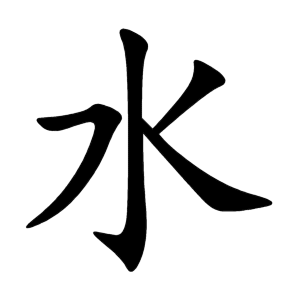水
- water;
Etymology
It is a pictograph that represents flowing water. The middle horizontal stroke symbolizes flowing water, and the strokes on both sides represent splashing water droplets.
As a side note, 川 (stream, river) also depicts flowing water but has evolved differently from 水.
Usage in Korean
Besides 삼수변, there are other water-related radicals like 물수부발 (氺), classified 85th in the Kangxi dictionary, which appears in characters like 泰 (great) and 求 (seek).
Characters with the water radical often relate to liquids or water-related meanings.
Examples include:
液 (liquid)
泉 (spring)
氷 (ice)
泳 (swim)
深 (deep)
江 (river)
河 (river)
湖 (lake)
海 (sea)
洋 (ocean)
泌 (secrete)
洐 (ditch flow)
淼 (vast water)
氹 (pond)
There are rare characters that use the full 水 shape as a radical, such as 沀 (ditch).
Alternative forms
Characters with 水
6 strokes
7 strokes
8 strokes
- 沮–to block, to hinder, to obstruct, to discourage, to frustrate
- 河–river, flowing water
- 油–oil, grease, fat
- 治–to govern, to rule, to cure, to treat (illness), to control, to regulate, to punish
- 況–situation, condition, state of affairs, furthermore, let alone
- 泊–to anchor, to moor, to stay temporarily, to rest beside water
- 法–law, rule, method, principle
- 泡–bubble, foam, froth
- 波–wave, ripple, flow, undulation
- 注–to pour, to flow, to irrigate, to focus, to concentrate
9 strokes
- 泉–spring, fountain, source of water
- 洋–ocean, vast sea
- 洑–weir, dam, water barrier, to flow gently, to seep or percolate
- 洒–to wash, sprinkle, scatter water, purify
- 洗–to wash, cleanse, rinse
- 洙–riverbank, water’s edge
- 洞–valley, hollow, cave, village, settlement
- 津–ferry, ford, crossing point in a river, sap, liquid
- 洪–vast, great, immense, flood, deluge
- 洲–sandbank, islet, shoal, river islet
- 活–to live, to be alive, lively, active, flowing, moving, fresh
- 派–branch, stream, faction
- 流–to flow, to circulate, to drift, to spread, to diffuse
10 strokes
- 浩–vast, wide, extensive, grand, great
- 浪–wave, surf, flow, to drift
- 海–sea, ocean
- 浸–to soak, to sit in water (or liquid)
- 涇–name of the Jing River, to flow, to pass through
- 消–to disappear, to vanish, to reduce, to eliminate
- 涉–to cross (a river or body of water), to step through, to wade through
- 涌–to spring forth, to gush, to well up, to surge
11 strokes
12 strokes
13 strokes
14 strokes
- 滯–to be blocked, delayed
- 滿–full, filled, to fill, to satisfy, abundance, satisfaction
- 漁–to fish, to catch fish, to angle, to gather aquatic life
- 漂–to drift, to float, to wander, to move about, to wash, to rinse (as in laundry)
- 漆–lacquer, varnish, the sap of the lacquer tree
- 演–to spread out, to extend, to perform, to act, to explain, to expound, to evolve, to develop
- 漠–vast, boundless, desolate, silent, desert
- 漢–Sino-, China
- 漣–ripple, small wave, faint undulation on water
- 漫–scatter, overflow, freely
- 漸–gradually, by degrees, little by little, to advance slowly
15 strokes
16 strokes
17 strokes
25 strokes
Words that derived from 水
- 냉수(冷水)–cold water
- 대홍수(大洪水)–great flood; cataclysm; deluge
- 수(水)–Wednesday
- 수도(水道)–water supply; waterworks; sewerage; faucet
- 수도꼭지(水道꼭지)–faucet
- 수라(水剌)–royal meal
- 수로(水路)–water way; channel; water route
- 수륙(水陸)–land and sea; land and water route
- 수리(水利)–utilization of water
- 수상(水上)–water way; being on the water; upstream; upriver
- 수심(水深)–water level; depth of water
- 수요일(水曜日)–Wednesday
- 수정(水晶)–crystal
- 수준(水準)–standard; norm; average
- 유수(流水)–running water
- 음료수(飮料水)–drinking water; soda; soft drink
- 자수정(紫水晶)–amethyst
- 잠수함(潛水艦)–submarine
- 지하수(地下水)–groundwater
- 팥빙수(팥氷水)–shaved ice with red bean topping
水
물
수
mul
su
Kangxi radical:85
Strokes:4
Unicode:U+6C34
Cangjie input:
- 水 (E)
Composition:
- ⿰ 𰛄 ⿺ ㇏ 丿 (G J K V)
- ⿰ ㇇ 𰛅 (G J K V)
- ⿰ 𰛄 ⿱ 丿 ㇏ (H T)
